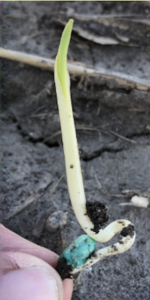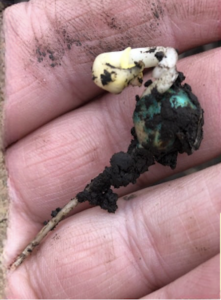When variable weather across the corn belt strikes, the pressure to know when planting conditions are right for your operation weighs heavy. Do you go or do you wait? What do you really need to be accounting for as you weigh the factors to make that decision?
Precision Agronomist Erika Parker shares three considerations for planting decisions and emergence watchouts you should be aware of this season.
- Imbibitional Chilling Injury
Planted corn consumes water to start its germination process. But when that water is cold, often associated with soil temperatures under 50°F, the cell membranes can become rigid and rupture, resulting in malformations.
Symptoms can include:
- Corkscrewed or malformed mesocotyls
- Aborted radicles
- Proliferation of seminal roots
- Seeds that swell but don’t germinate, or delayed growth.
Cool, damp conditions that result from this can also lead to seedling diseases that negatively impact the corn crop, especially in fields with a history of such diseases. The Water and Atmospheric Resources Monitoring Program (WARM) is a useful resource for monitoring soil temperatures.



- Leafing Out Due to Time in Cold Conditions
Corn has approximately 3 weeks to emerge before its internal clock starts allowing that coleoptile to rupture even in the absence of sunlight.
Corn seedlings are protected with the coleoptile, which acts as a shield or a football helmet to help the seedling push through the soil and emerge. The coleoptile can rupture due to sunlight, mechanical injury, or time. In a perfect world, the coleoptile pushes through the soil, spikes through the ground, sees sunlight, and ruptures, allowing the leaves to become exposed to sunlight and develop normally. Cloddy soils can allow light to hit it before it’s truly above ground. Cloddy soils can allow light to hit it before it’s truly above ground. In 2023, there is a real risk of the protective layer rupturing too early due to delayed emergence, resulting in the seedling leafing out underground.
- Greatest Risks
Soybeans: The greatest risk for planting soybeans early is that they will emerge and be damaged by frost. This risk is larger with no-till as residue increases the risk for frost damage to the young soybean seedlings. Frost date maps can be found here.
The forecast across much of our footprint is not favoring rapid emergence of soybeans, which can reduce risk of frost damage. That said, planting worked ground first can reduce the small risk even more.
Corn: The risk of imbibitional chilling and leafing out due to excessive time prior to GDU accumulation are the primary concerns that are weighed against the concerns of rain delays that may result in planting in late May and or planting into less than-fit conditions and/or battling a crust that can often happen in challenging soils.
Ground that is poorly drained will extend the time to emergence. With every operation having different labor and equipment situations, there are obviously non-agronomic factors that weigh into the choice to plant corn.
For many, it makes sense to get a small portion of their corn in the ground to make sure that everything will work as efficiently as possible if a small window presents itself with truly favorable conditions. If the choice is made to plant corn, targeting dark well-drained fields can help minimize the risk of corn injury.
Moving Forward
- In many situations, planting soybeans provides the most upside yield potential with limited risk.
- Be prepared to wait for emergence. Be patient and diligent in your evaluations. In situations where planting corn is needed for your operation, targeting fields that are well drained with high organic matter can help reduce the risk of cold injury.
- Continue to observe crop growth and development for planted crops. Replant decisions can’t really be made until the seedlings have truly shown us if they are going to emerge, leaf out underground, or cease development, which is likely to be about 3 weeks from the planting date.
- Be prepared to wait for emergence. Be patient and diligent in your evaluations.
Although we cannot control Mother Nature, gathering more information to make informed decisions can help reduce uncertainty this season. The team at Advanced Agrilytics is ready to assist you in navigating the season’s challenges. Connect with our team at: advancedagrilytics.com/contact.